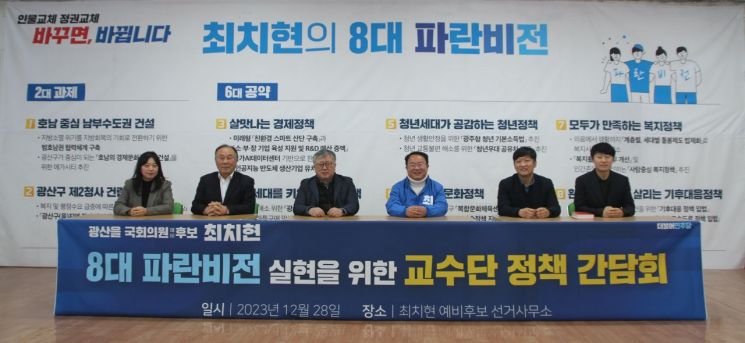Choi Chi-hyun: Gwangsan District in Gwangju to Transform into UAM Hub
Jan. 29. 2024Page info
Future-oriented transportation project with expectations for economic revitalization
Utilizing abandoned Imkok Station and redevelopment area
Choi Chi-hyun, a prospective candidate for the Gwangju Metropolitan City Gwangsan District constituency in the upcoming parliamentary elections, announced on the 11th that he plans to drive the Urban Air Mobility (UAM) project as a new economic policy to develop Gwangsan District into a smart city. The goal is to create sustainable employment and secure future industries.
Choi, in collaboration with policy advisory committee members and economic policy discussions, explored the UAM project as a novel economic policy direction and delved into a detailed analysis. The UAM project involves a revolutionary transportation system with vertical takeoff and landing aircraft, gaining attention as a solution to urban traffic congestion with high time efficiency.
Often referred to as flying taxis, the UAM project's core lies in technology and fuel, conditions that Gwangju meets with companies like Kia Motors and hydrogen company HogreenAir.
Furthermore, by repurposing the decommissioned Imkok Station as a UAM terminal and developing the approximately 100,000 square meters of Imkok-dong redevelopment area into a research and demonstration cluster complex linked to the UAM project, Choi expects the creation of high-quality sustainable jobs and the revitalization of the Gwangsan District's economic outlook through the activation of the Imkok area.
Choi's assessment includes the construction of UAM vertiports as a key element in the core infrastructure of urban air transportation in downtown areas. He notes that Gwangju's local construction companies possess the necessary technological capabilities, and with the potential participation of telecommunication giants KT and SKT in 6G communication technology development, the city has sufficient communication infrastructure.
In addition to its anticipated impact on technological advancements and industrial growth in Gwangju's future mobility sector, Choi suggests exploring possibilities for attracting and collaborating with Samsung Electronics, utilizing the available space in the Hanam factory.
Moreover, if linked with hydrogen company HogreenAir's research on liquefied hydrogen, and the hydrogen drone cluster, Choi expects a broad range of technological advancements in related fields, positioning Gwangsan District as an advanced logistics and a new transportation hub.
Given that hydrogen drones capable of flying for 13 hours on a single charge have already been developed, the industry projects the UAM project's outlook value to range from approximately 731 trillion to 1800 trillion, emphasizing Gwangsan District's role as a pioneer in the era of airborne transportation.
Choi expresses optimism about connecting with the tourism industry in the surrounding areas such as Mt. Mudeungsan, Damyang, Hwasun, Jangseong, and Naju. He believes that by doing so, Gwangsan District can contribute to solving the challenges in the southern capital region and become the key to recovering from regional crises as a tourism and industry collaborative effort.
Choi states, "The UAM project will not only boost the local economy but will also serve as a blue ocean strategy for Gwangsan District, simultaneously lifting up culture, industry, and regional development."
He has presented an 8-point vision, including the development of a future-oriented eco-friendly smart industrial complex, support for small, medium, and large enterprises, and an increase in R&D budgets, outlining economic policies for fostering future industries and technological innovation in the economic sector.
Choi Chi-hyun emphasizes, "In an era where flying taxis as seen in the movie 'Back to the Future' are already developed and on the brink of commercialization, Gwangsan District in Honam will take the lead in the UAM project. With seven industrial complexes in Gwangsan District, which already serves as a forefront base for job creation and future industries in Gwangju, a new logistics solution is needed, and that is precisely the UAM project, the future transportation method."
